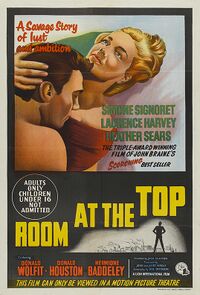Room At The Top
Relevance
Via Australian radio interview ("Carry On Down Under", 1985):
"You've got quite a fascination with films from the 60's.
Yes, indeed.
What is it about them that you like?
I'm afraid that they probably remind me of my childhood because I lived in lots of those circumstances. I gaze upon it fondly because it was the first time in the entire history of film where regional dialects were allowed to come to the fore and people were allowed to talk about squallor and general depression and it wasn't necessarily a shameful thing. It was quite positive. I mean if you notice films, British films, of the late 1950's even - films which deal with army themes, or war themes, or the people who were in the army or whatever - all the actors have wonderfully crisp theatrical voices. But from, I think, Room At The Top, 39th, and Saturday Night And Sunday Morning onwards, people were just allowed to be real instead of being glamorous and Hollywoodian - if that's a word, and I sincerely hope it isn't. Sounds awful!"
Wikipedia Information
 |
Room at the Top is a 1959 British drama film based on the 1957 novel of the same name by John Braine. It was adapted by Neil Paterson (with uncredited work by Mordecai Richler), directed by Jack Clayton (his feature-length debut), and produced by John and James Woolf. The film stars Laurence Harvey, Simone Signoret, Heather Sears, Donald Wolfit, Donald Houston, and Hermione Baddeley. The film was widely lauded, and it was nominated for six Academy Awards, winning two: Best Actress (Signoret) and Best Adapted Screenplay (Paterson). Its other nominations at the 32nd Academy Awards were for Best Picture, Best Director (Clayton), Best Actor (Harvey), and Best Supporting Actress (Baddeley). Baddeley's performance, consisting of 2 minutes and 19 seconds of screen time, is the shortest ever to be nominated for an acting Oscar.
